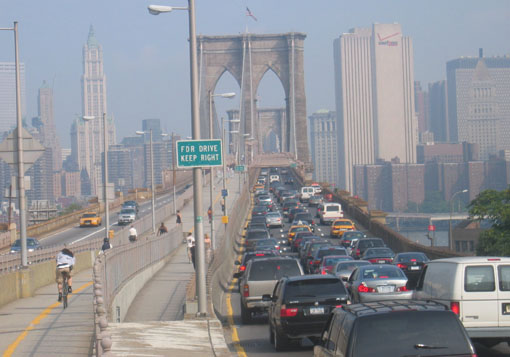New York State should postpone its January 1 surcharges on taxi rides until the startup of congestion pricing.
The surcharges on fare trips south of 96th Street by taxis and app-based services like Uber and Lyft are intended to bring in $400 million a year for the MTA. Delaying and/or reducing the surcharges until the rollout of full congestion pricing could cost the authority a half-a-billion dollars, maybe more.
Like everyone who fights for affordable and reliable mass transit — the lifeblood of our city and region — I want to help the MTA become solvent.
But I am convinced that the new surcharge will deal a brutal blow to the people who drive and own yellow cabs. And I’m worried that the unfairness of a “congestion surcharge” that balances the MTA’s budget on the backs of taxi drivers will be so palpable that it will tarnish congestion pricing’s “brand.” This, I fear, could jeopardize the push to solidify public support for congestion pricing — support that is needed in order to pass it in the state legislature after the New Year.
Throughout my years advocating and modeling congestion pricing, I’ve insisted that all for-hire vehicles — yellows, Ubers, Lyfts, etc. — be surcharged in tandem with private cars and trucks. With for-hire-vehicles now accounting for close to half of all vehicle miles traveled in the Manhattan Central Business District (roughly 22 percent by yellows, 25 percent for the app-based vehicles), charging them for occupying the district’s scarce street space has never been more essential.
But that is just as true for private vehicles — serving less of a public purpose than the for-hire vehicles —that make up the other half of CBD traffic. And I have been steadfast in insisting that neither toll element be done without the other. In particular, yellow cabs must not be surcharged for servicing fares in the Manhattan taxi zone unless and until cars and trucks pay to enter the CBD.
A central premise of congestion pricing was that all of its elements would kick in at the same time. With congestion pricing synchronized — autos and trucks paying to enter the central charging zone; taxis and Ubers paying for time traveling in or occupying the zone — the for-hire drivers can win back through faster travel the fares they stand to lose from surcharges boosting the price of a ride.
But that arrangement breaks down if the taxi congestion surcharges are implemented alone. Without cordon pricing, demand for Ubers and yellows — especially yellows — will diminish.
The threat is most dire for the yellows. The state-mandated surcharges are 100 percent loaded on the up-front “drop” part of the fare that will hit taxi users like a punch to the jaw. The surcharges also guarantee Uber Pool or Via customers a 70% lower surcharge than a yellow (75 cents vs. $2.50) simply for requesting a pooled ride, even if no other passenger shows up.
And if that gaping loophole isn’t invitation enough to game the system, there’s always the monopolists’ time-honored tactic of lowering the price to kill the competition — a luxury that yellow drivers and owners can’t afford.
The congestion surcharges won’t shrink the various for-hire vehicle services equally. Rather, almost the entire shrinkage will be borne by the immigrant-dominated yellows as the combination of the price impact and cutthroat competition decimates what’s left of the taxi industry.
What is to be done? Here are six steps toward a fair and economically sustainable congestion surcharge:
- Get Albany to defer large-scale congestion surcharges on yellow cab rides until congestion pricing’s cordon charges take effect.
- Also cut the Uber/Lyft surcharges while requiring those services to implement universal digital connectivity no later than April 1, 2019.
- With universal connectivity in effect (the yellows already have it), toss out the app-based vehicles’ lump-sum congestion surcharge, and base it instead on time with a passenger in the zone — a charge that corresponds closely to congestion causation.
- Expand the app-based surcharges to include a supplemental charge for “trawling” — Uber and Lyft drivers sitting in the zone (and snarling traffic) while waiting to be pinged.
- Replace the 75-cent surcharge for pooled rides with a surcharge that reflects their lesser congestion impact without giving away revenue and unfairly undercutting yellow rides.
- Introduce a time-in-the-zone-based surcharge for yellows; but no trawling charge, insofar as the yellows are limited in number and their business model requires them to cruise for street hails.
Yes, these steps will cost the MTA revenue. But the upside of congestion pricing’s revenue promise is orders of magnitude greater.
At the TLC hearing last week on the surcharges, anguished drivers labeled the taxi surcharges “congestion pricing.” On Wednesday at City Hall, they will unveil a "Stop the Suicide Surcharge" banner, a slogan that reflects the eight taxi driver and owner suicides over the past year. Whether or not that’s fair — and I think in many ways it is — the label may stick, especially if more drivers take their own lives as conditions deteriorate.
All of us in the long campaign for congestion pricing have been committed to making congestion pricing fair — not just to be on the winning side, but to be on the right side. Let’s keep it that way.
Disclaimer: Since Nov. 1 I have been retained by taxi medallion interests to evaluate proposed TLC regulations for monitoring, accounting for, and implementing the congestion pricing surcharge.
Streetsblog comment: The opinion of Charles Komanoff is just that: The opinion of one of America's best respected experts on pricing the street. It does not necessarily reflect the opinion of Streetsblog.






